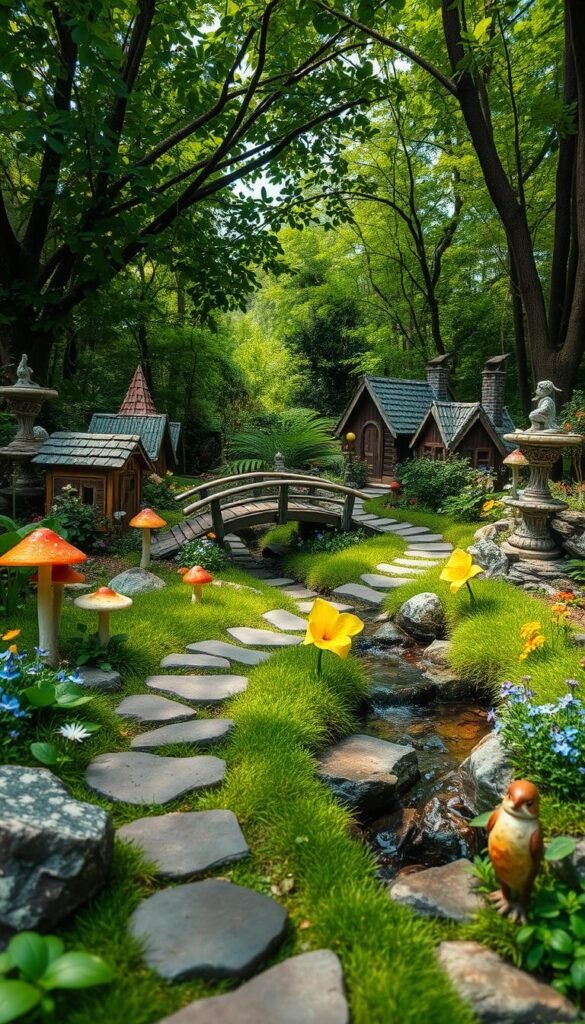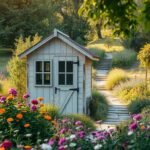Step into a realm where creativity blooms and tiny wonders come to life. Crafting your own miniature paradise lets you blend nature’s charm with playful imagination. These projects are perfect for adding magic to patios, tabletops, or even indoor spaces. Best of all, you don’t need expert skills—just a love for whimsy and a sprinkle of inspiration.
Whether you’re designing a cozy cottage scene or a mystical woodland retreat, the possibilities are endless. Use pebbles for pathways, repurpose teacups as tiny ponds, or turn twigs into rustic fences. Every detail transforms ordinary items into enchanting accents. Even beginners can create stunning displays with basic supplies like soil, plants, and miniature decor.
What makes these projects special is their flexibility. You can start small with a potted garden or go big with an outdoor oasis. Upcycle old containers, thrift-store finds, or backyard treasures to keep costs low. Personalize your creation with fairy lights, tiny figurines, or seasonal themes. The goal? To build a space that feels uniquely yours—a pocket-sized escape that sparks joy.
Ready to dive in? Let’s explore how simple materials and a dash of creativity can craft a world where fantasy thrives. Your journey to a magical miniature landscape starts here.
Finding Inspiration for Your Enchanted Fairy Garden
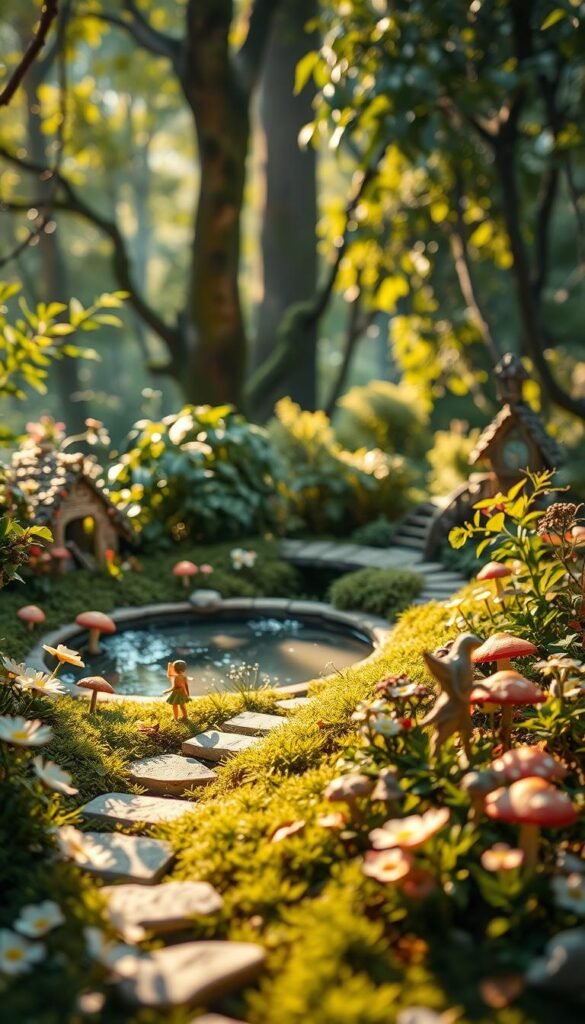
Ever wonder why tiny landscapes feel so captivating? These magical spaces let you design entire worlds in the palm of your hand. Whether you’re working with a windowsill or a patio corner, they transform ordinary areas into storytelling hubs.
Why Miniature Worlds Spark Joy
There’s something irresistible about shrinking nature’s beauty. “It’s not just dirt and plants—it’s a stage for imagination,” says one hobbyist. Children see play spaces, while adults rediscover childhood wonder. The small scale makes projects manageable, letting you experiment without overwhelm.
Learning Through Digital Guides
Online tutorials are goldmines for fresh concepts. Search for “best fairy garden” videos, and you’ll find terracotta pot transformations or mossy woodland scenes. Many creators share:
- Budget-friendly swaps like bottle cap ponds
- Seasonal themes using fallen leaves
- Lighting tricks with LED tea lights
Platforms like Pinterest showcase global styles—from cottagecore to desert oases. Follow a diy fairy garden tutorial to build skills gradually. Pro tip: Join forums where enthusiasts troubleshoot sticky clay or share moss-growing hacks. Every project teaches something new!
Gathering Materials and Supplies for Your Fairy Haven
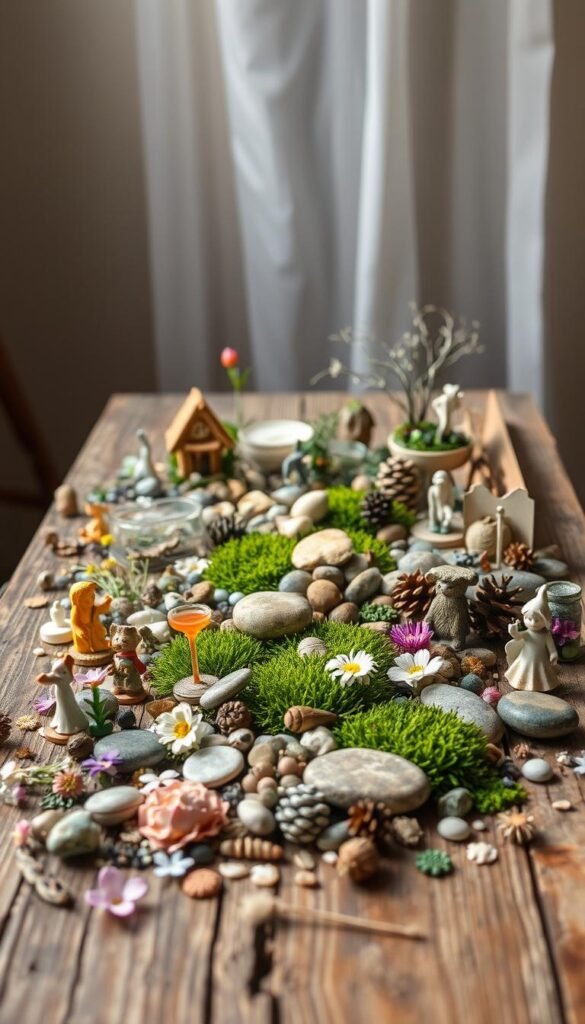
Your fairy haven begins with a collection of simple yet imaginative materials. The best part? You likely own many items already. Let’s explore what you’ll need to turn everyday objects into magical features.
Essential Craft Supplies
Start with basics like polymer clay for sculpting tiny furniture or mushrooms. Acrylic paints add color to miniature houses, while hot glue guns securely attach delicate pieces. Don’t forget sheet moss for lush ground cover or pebbles for winding pathways.
Recycled and Natural Items Tips
Old mason jars become glowing lanterns, and broken terracotta pots transform into tiered gardens. For rustic charm, use twigs as fences or pinecones as fairy trees. Learn how to start a fairy with bottle-cap ponds or popsicle-stick bridges. Even acorns work as adorable decor!
| Material Type | Examples | Uses |
|---|---|---|
| Essential Supplies | Polymer clay, paint, moss | Sculpting, coloring, landscaping |
| Recycled Items | Mason jars, popsicle sticks | Containers, furniture, structures |
| Natural Elements | Twigs, stones, pinecones | Pathways, fences, decorative accents |
Need inspiration? Check out DIY garden art projects for clever upcycling ideas. Remember: creativity matters more than perfection. A cracked teacup? It’s now a whimsical planter!
Planning and Sketching Your Miniature Landscape
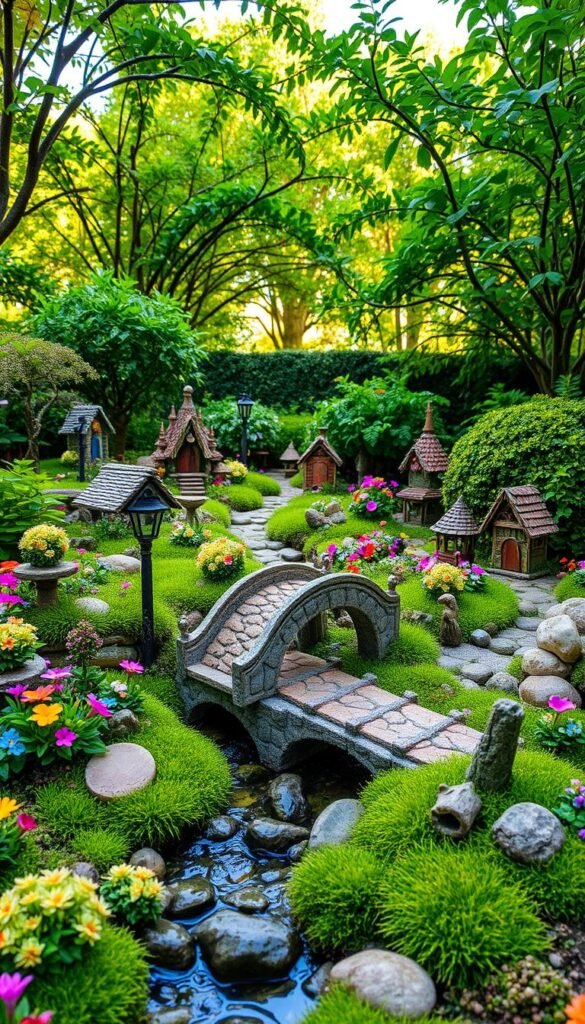
Creating a tiny world starts with a vision and a sketch. Grab paper and pencil to map out your ideas before touching soil. Consider your container’s shape—round bowls suit circular pathways, while rectangular planters allow layered designs. Jot down where key elements like cottages or ponds will live.
Visualizing Your Fairy Garden Layout
Think like a movie director designing a set. Where will the story unfold? Place taller items like trees at the back for depth. Leave space between features so plants can grow. “Curved paths feel more natural than straight lines,” notes hobbyist Lara Simmons.
Practical details matter too. Ensure easy access to water delicate plants. If using real moss, pick shady spots. For outdoor setups, choose weather-proof materials like resin figurines.
| Planning Aspect | Considerations | Pro Tips |
|---|---|---|
| Space Allocation | Container dimensions vs. decor size | Use coins to mock up item placement |
| Focal Points | House placement, water features | Elevate key pieces with small rocks |
| Path Design | Pebble vs. bark chip paths | Add forks to suggest hidden areas |
Stick to one color palette—earthy tones for woodland themes, pastels for cottages. Sketch 2-3 versions before finalizing. This prep work helps you make fairy garden magic without costly re-dos later!
Setting Up the Garden Base and Containers
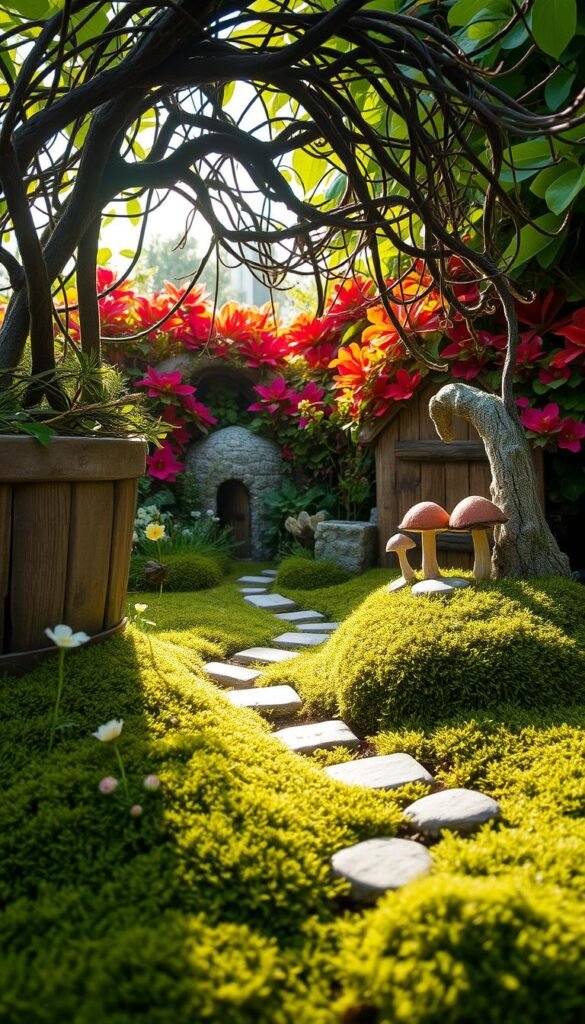
The foundation of your tiny paradise starts with choosing the right home for it. Containers shape your design’s scale and story—whether you’re crafting a cozy nook or an expansive woodland scene. Let’s explore how everyday items like pots and jars become magical landscapes.
Using Flower Pots and Mason Jars
Terracotta pots are classics for good reason. Their earthy texture blends with natural themes, and drainage holes prevent soggy roots. Paint them pastel for cottage charm or leave them rustic for woodland vibes. Small flower pots work wonders on shelves, while larger ones let you build multi-level scenes.
Mason jars offer a different kind of magic. Their glass walls reveal hidden details like pebble pathways or tiny root systems. Add a layer of charcoal at the bottom to keep soil fresh—perfect for succulents or air plants. Pro tip: Turn jars sideways to create whimsical hanging displays!
| Container Type | Best For | Prep Tips |
|---|---|---|
| Flower Pots | Outdoor/indoor use | Use gravel base for drainage |
| Mason Jars | Indoor displays | Add moss to retain moisture |
| Upcycled Items | Budget-friendly projects | Drill holes if needed |
Thinking bigger? Large containers let you mix plants like creeping thyme and mini ferns. For mobility, try lightweight plastic pots. If you love affordable DIY projects, repurpose old buckets or tin cans—just add personality with paint!
15 DIY Fairy Garden Ideas for Crafting a Whimsical Miniature World
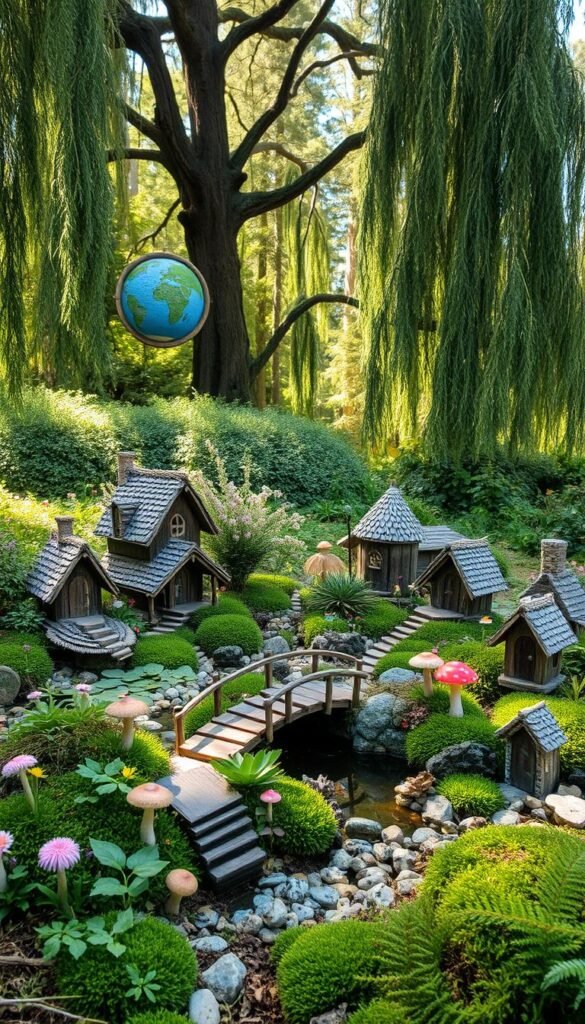
Transform everyday items into enchanting scenes with these imaginative projects. From rustic stone cottages to magnetic kitchen displays, each design blends simplicity with storytelling magic. The key? Pairing accessible materials with step-by-step guidance that makes creativity feel effortless.
Showcase of 15 Creative Projects
Paint terracotta pots to craft vibrant cottages surrounded by mossy lawns. Turn wooden birdhouses into farm-style barns with tiny hay bales and wire fences. For indoor charm, decorate a pencil box with sheet moss and secure it to your fridge using magnets—a whimsical surprise for anyone grabbing snacks.
Prefer natural textures? Stack flat stones into cozy cabins topped with bark roofs. Or repurpose wicker baskets into woodland scenes using branch pathways and pebble streams. Each project matches different skill levels, whether you’re arranging teacup planters or sculpting polymer clay mushrooms.
Integrating Tutorials and Step-by-Step Guides
Online resources simplify complex builds. Watch videos demonstrating how to seal clay cottages for outdoor use or create decoupage mason jars. Many guides include:
- Material swaps (like using coffee stirrers instead of popsicle sticks)
- Weatherproofing tips for stone installations
- Lighting hacks with battery-operated LEDs
| Project Type | Materials Needed | Skill Level |
|---|---|---|
| Magnetic Displays | Wooden boxes, sheet moss | Beginner |
| Polymer Clay Sculpts | Oven-bake clay, acrylics | Intermediate |
| Stone Cottage Builds | Flat rocks, bark, adhesive | Advanced |
Start with simpler designs like flower pot gardens, then tackle galvanized washtub displays as confidence grows. Remember: Every tiny detail adds personality to your pocket-sized paradise.
Designing and Crafting Unique Fairy Garden Houses
The heart of your miniature realm lies in its tiny homes—structures that spark curiosity and invite storytelling. Whether rustic or refined, these dwellings anchor your design’s theme while showcasing your style.
From Birdhouses to Whimsical Cabins
Start with wooden birdhouses as blank canvases. Paint them sky-blue or moss-green, then glue pebble roofs for texture. Add 3-D clay flowers around windows or tiny twig balconies. Pro tip: Use Spanish moss to soften edges, creating an aged, storybook feel.
Sculpting Lasting Clay Creations
Shape polymer clay over cans to form curved walls. Carve stone-like textures or add scalloped eaves before baking. Once hardened, these houses withstand rain, making them ideal for outdoor displays. Top with bark shingles or miniature ivy for charm.
Not into sculpting? Popsicle sticks become cozy cabins. Layer them log-style, then accent with dried leaf awnings or acorn doorknobs. Every choice—like choosing wood over clay—adds personality. Let your tiny houses reflect what magic means to you!

